5 Step Plan for Safe Tree Felling with a Chainsaw
- December 8, 2023
- 0 comment
When it comes to the precise and potentially hazardous task of tree felling, particularly using a chainsaw, it is crucial to approach the process with a blend of expert knowledge, meticulous planning, and an unwavering commitment to safety. The Step Plan for Safe Tree Felling is an essential guide, crafted from the collective wisdom of forestry and arboriculture professionals. This systematic approach is not merely about making cuts; it’s a strategic framework designed to ensure safety, precision, and efficiency in the complex process of tree removal.
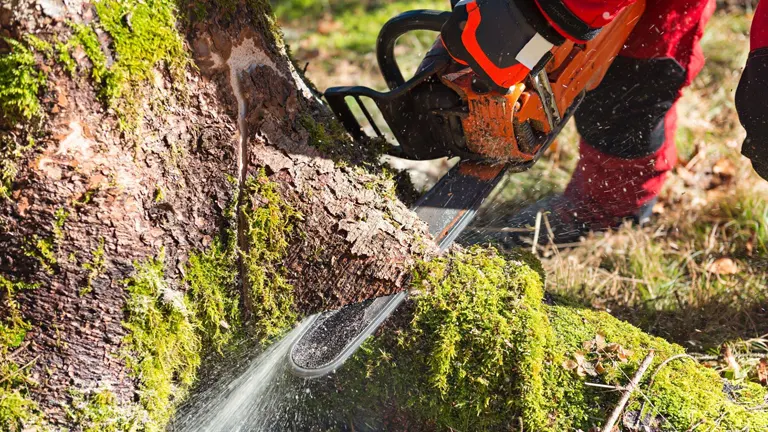
Felling a tree, especially in controlled environments, is a task that demands much more than just physical strength and the basic operation of a chainsaw. It involves a deep understanding of tree biology, physics, and environmental factors. Each step in this plan is a critical component in a sequence of decisions and actions, all aimed at minimizing risk and ensuring the safe, controlled, and effective felling of a tree.
In the following sections, we delve into each step of the Step Plan for Safe Tree Felling, providing a clear, informative, and practical guide to help you execute this task with the highest standards of safety and efficiency.
1. Assessing Tree Height, Hazards, and Lean
The first step involves a careful assessment of the tree’s height, identification of potential hazards, and evaluation of the tree’s lean. Accurately determining the tree’s height is crucial as it affects the assessment of potential hazards in its fall path. While various methods exist for estimating tree height, such as using cell phone apps or a clinometer, a practical and commonly used technique at the worksite is the “stick trick.” This method requires a stick held at arm’s length, aligned with the notch-cutting point on the tree. By walking backward and aligning the stick with the tree’s top, one can estimate where the top of the tree will land when it falls. This estimation should be adjusted based on the tree’s lean and the slope of the land; for instance, forward lean or downhill slopes can lead to an overestimation of height, while back lean or uphill slopes can result in underestimation.
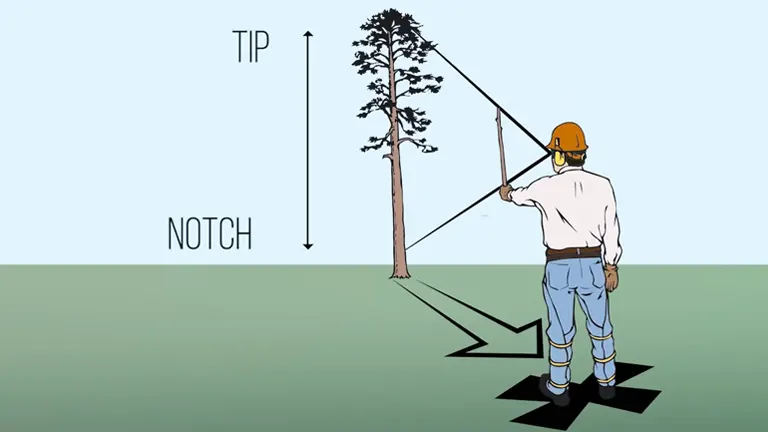
In addition to height, identifying potential hazards is essential. This includes inspecting the area around the tree for buildings, power lines, other trees, wildlife, and any other elements that could be impacted by the falling tree. The tree’s health should also be assessed for signs of internal rot or unstable branches (widow makers) that could pose risks during the felling process.
Evaluating the tree’s lean is another critical aspect. A simple method for assessing lean involves creating a circle with your fingers and thumbs and framing the tree’s canopy through it. By visualizing a line dropping from this circle to the ground, you can determine how far the lean is from the base of the tree. This assessment should be done both in the intended direction of the fall and at a 90-degree angle to it. If the tree has significant side lean, it might not fall as planned, necessitating an adjustment in the felling strategy or even a reevaluation of whether it’s safe to fall the tree in the desired direction.
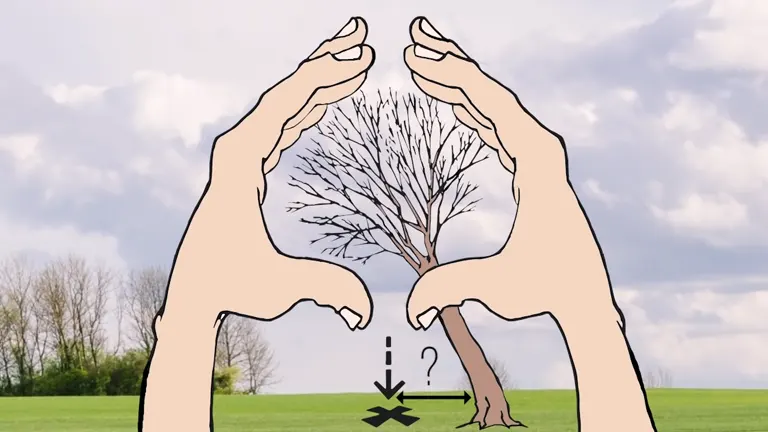
Concluding this step, you should have a clear understanding of the tree’s height, the surrounding hazards, and its lean, which are all critical for planning the safe felling of the tree. This assessment lays the groundwork for a controlled and predictable felling operation, ensuring both safety and efficiency.
2. Equipment Selection: A Necessity for Safety and Efficiency
The second step is all about selecting the right equipment for the job, emphasizing both personal safety and the effective execution of the tree-felling process.
Personal Protective Equipment (PPE)
Safety is paramount in tree felling, and it starts with wearing the appropriate personal protective equipment. This includes:
- Helmet: Essential for head protection from falling branches or debris.
- Safety Glasses: Protect your eyes from sawdust and wood chips.
- Ear Protection: Chainsaws are loud, and prolonged exposure to this noise can damage hearing.
- Gloves: Provide a better grip and protect your hands.
- Chainsaw Pants or Chaps: Specially designed to protect your legs from accidental chainsaw cuts.
- Boots: Preferably with steel toes for foot protection.
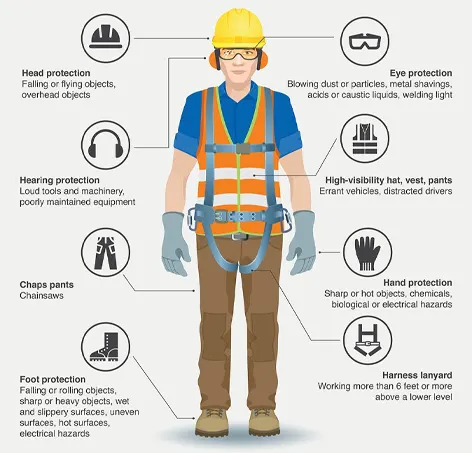
Chainsaw and Additional Equipment
Chainsaw
The primary tool for the job. It’s crucial to use a chainsaw that is well-maintained and has a bar length slightly longer than the diameter of the tree to be felled. The chain should be sharp and in good condition to ensure clean cuts and reduce the risk of kickback.
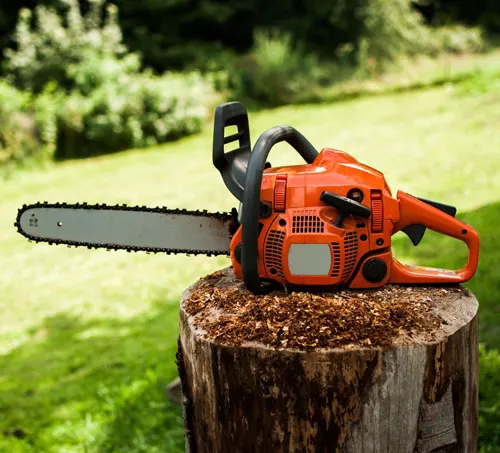
Throw Line and Rope or Mechanical Advantage Set
If the tree has significant back or side lean, these tools can help guide the tree in its intended fall direction. They are particularly useful for pulling the tree over during the final stages of the cut.
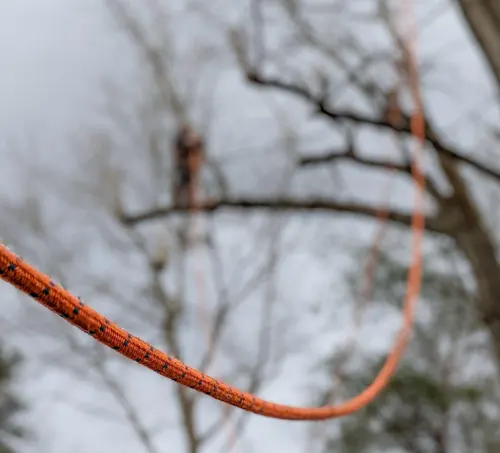
Wedges
A must-have on any felling site. Wedges help in directing the tree’s fall and can provide a mechanical advantage, especially in trees with a certain lean. It’s a good practice to place a wedge in the back cut of any tree being felled, as this can significantly influence the direction and safety of the fall.
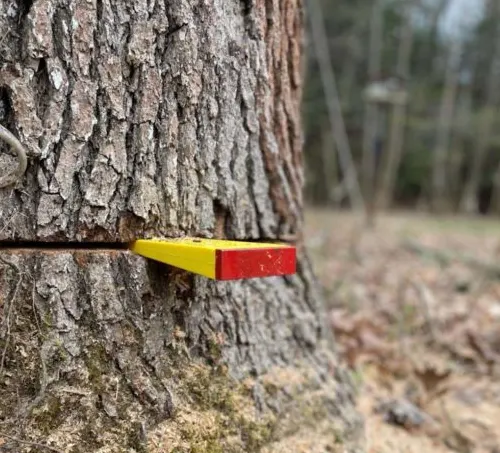
Before beginning the felling process, ensure all necessary equipment is gathered and positioned near the base of the tree. This step is not just about having the right tools but also about being fully prepared for the task at hand. If any essential equipment is missing or not in proper working condition, it’s safer to postpone the felling until everything required is available and in good order. This cautious approach underscores the importance of preparation and safety in tree-felling operations.
3. Planning the Escape Route: A Lifesaving Step
The third step is planning your escape route, which is crucial for ensuring personal safety during the tree-felling process. This step is all about establishing a clear and safe path to quickly move away from the tree as it begins to fall.
Designing the Escape Route
Direction
The planning of the escape route is a strategic element in tree-felling safety. The ideal escape route should be positioned at a 45-degree angle from the direction in which the tree is anticipated to fall. This specific angle is selected to enhance safety by avoiding the direct path of the falling tree and any debris that may rebound or roll in the immediate aftermath of the tree hitting the ground.

Clearing the Path
It’s crucial to prepare the escape route before initiating any cuts on the tree. This preparation involves meticulously clearing the path of any branches, debris, or obstacles that could obstruct movement. A cluttered escape route poses a significant safety hazard, potentially leading to tripping or entanglement, which can be particularly dangerous during a hasty retreat from a falling tree.
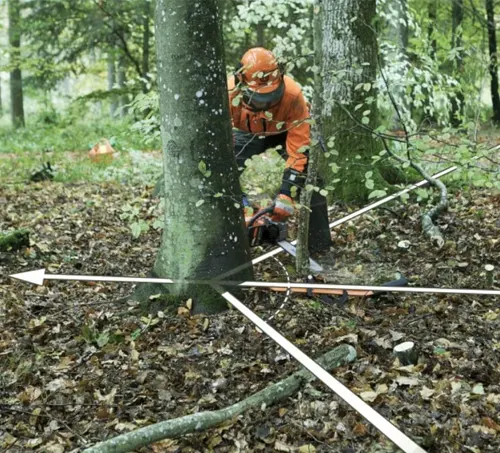
Using the Escape Route
Timely Exit
Once the tree begins its descent, prompt and composed movement along the pre-planned escape route is essential. Statistically, the majority of accidents during tree felling happen within the critical 15-second window after the tree starts moving and within a five-foot radius from the trunk. This risk pattern is encapsulated in the “90-15-5 rule,” underscoring the importance of the initial moments following the commencement of the tree’s fall.

Staying Alert
Maintaining vigilance during the tree’s descent is non-negotiable. One of the key safety rules is to never turn your back on a falling tree. The dynamics of a falling tree can be unpredictable, and being able to visually monitor its descent allows for quicker response to any sudden changes in direction or unexpected movements. This continuous observation helps in reacting promptly to ensure personal safety as the tree falls.
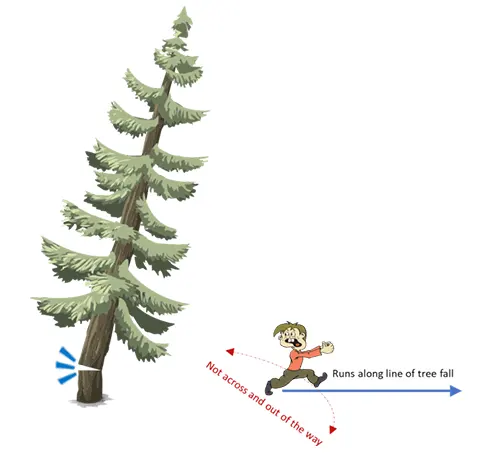
Planning and using an escape route might seem like a straightforward task, but it’s a lifesaving aspect of tree felling. This step demands as much attention and care as the actual cutting of the tree. By thoughtfully planning and clearing an escape route, and by being prepared to use it immediately once the tree begins to move, one can significantly reduce the risk of accidents during the felling process. This proactive approach to safety is a key component of responsible and professional tree-felling practices.
4. Making the Notch: Setting the Direction
The fourth step is the precise cutting of the notch, which plays a crucial role in determining the direction in which the tree will fall. This step requires careful execution as it sets the foundation for a controlled and predictable felling process.
Choosing the Notch Type:
Open-Faced Notch
The preferred method is the open-faced notch, which involves cutting an opening of 70 to 90 degrees into the side of the tree facing the direction of the intended fall. This type of notch provides several advantages:
- It allows for greater control over the direction of the tree’s fall.
- The wide angle of the notch helps in preventing the tree from prematurely slipping or rolling.
- It provides a clearer view of the hinge while making the back cut, which is crucial for maintaining control during the felling process.

Conventional or Humboldt Notch
For those more comfortable with traditional methods, a conventional 50-degree notch or a Humboldt notch is also acceptable. The conventional notch is simpler to cut but offers slightly less control compared to the open-faced notch. The Humboldt notch, on the other hand, is often used in situations where conserving the length of the log is important.

Execution of the Notch Cut
- The notch should be cut cleanly and precisely. The depth of the notch should typically be about one-third of the diameter of the tree.
- The two cuts that form the notch must meet precisely without leaving any overhanging material, as this can affect the tree’s fall direction.
- The accuracy of the notch cut is imperative in guiding the tree to fall in the desired direction and is a critical step in ensuring the overall safety and success of the felling operation.
5. The Bore or Back Cut: Finalizing the Fall
After successfully cutting the notch, the fifth and final step is to make either a bore cut or a back cut. This pivotal step is integral to establishing a hinge, which plays a crucial role in controlling the direction and manner of the tree’s fall, thereby ensuring precision and safety.
Establishing the Hinge
The hinge’s primary function is to guide the controlled movement of the tree, determining both the direction and speed of its descent. Acting as a pivot between the tree and its stump, the hinge is instrumental in preventing uncontrolled falls or dangerous kickbacks. The thickness of the hinge is dependent on the diameter of the tree.
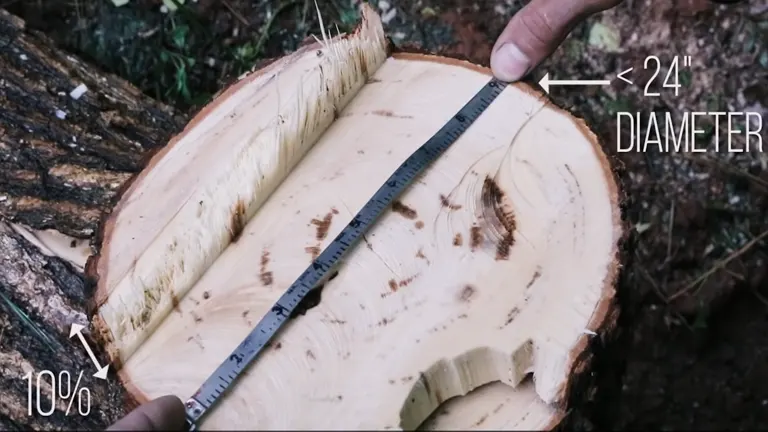
For trees with a diameter of 24 inches or less, the hinge should be approximately 10% of the remaining material after the notch is cut. In contrast, for trees with a diameter exceeding 24 inches, the hinge thickness should be around 5% of the remaining material. It’s vital to ensure that the hinge maintains a consistent width across the entire diameter of the tree, as this uniformity is key to ensuring the tree falls as intended, thus facilitating a safe and controlled felling operation.
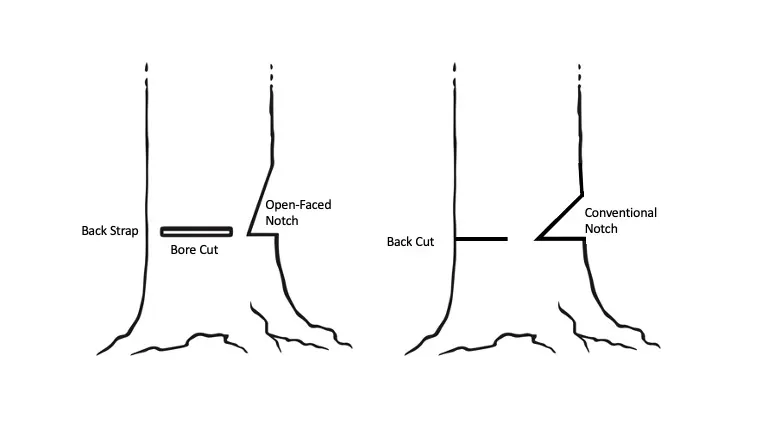
This final step, which involves choosing between a bore cut or a back cut, is essential in the tree felling process. It not only dictates the final moments of the tree’s fall but also significantly impacts the safety and effectiveness of the entire operation. Whether using a bore cut for more complex situations or a back cut for more straightforward scenarios, the focus is always on precision and control, culminating in a successful and safe tree felling.
Execution
- Whichever method is chosen, the cuts must be made with precision and care. The cuts should meet the edges of the notch cleanly, creating the intended hinge.
- The operator must be mindful of the tree’s movement during this process and be ready to retreat via the pre-planned escape route.
Conclusion
Following the plan for safe tree felling involves more than just cutting down a tree. It’s about executing the task in a manner that guarantees the safety of the person doing the felling and preserves the integrity of the surrounding area. This plan stands as a testament to the philosophy of “cut smart, cut safe,” emphasizing meticulous planning and precise execution to ensure a safe and successful felling process.
FAQs
- What is the basic approach to safely falling a tree with a chainsaw?
The basic approach involves a series of steps starting with assessing the tree and its surroundings, wearing appropriate personal protective equipment, planning an escape route, executing precise cutting techniques (notch and back cuts), and finally, carefully controlling the direction of the tree’s fall. - Why is personal protective equipment crucial in chainsaw operations?
Personal protective equipment is vital as it protects the user from potential hazards associated with chainsaw use, such as flying debris, loud noise, and the risk of injury from the saw itself. This includes helmets, eye and ear protection, gloves, protective trousers or chaps, and steel-toed boots. - How do you determine the direction in which a tree will fall?
The falling direction of a tree is primarily determined by its natural lean, the shape and weight distribution of its branches, and the direction of the notch cut made on the tree. Environmental factors like wind direction can also influence the fall. - What are the key factors to consider when planning an escape route?
The escape route should be clear of obstacles, at a 45-degree angle from the direction of the fall, and easily accessible. This ensures the feller can quickly move to a safe distance once the tree begins to fall. - Can any chainsaw be used for tree felling?
The chainsaw used should be appropriate for the size and type of tree being felled. It should be well-maintained, with a sharp chain and sufficient power to handle the tree’s diameter. - What is a notch cut and why is it important?
A notch cut is a V-shaped cut made on the side of the tree facing the intended direction of fall. It guides the tree to fall in a specific direction and helps prevent uncontrolled falls. - What is the difference between a bore cut and a back cut?
A bore cut is made by boring the chainsaw into the tree, parallel to the back of the notch, offering more control, especially in complex situations. A back cut is a straightforward cut made on the opposite side of the notch, determining the final direction of the tree fall. - How do you ensure safety while the tree is falling?
Always watch the tree as it falls, stay alert to any changes, and be ready to use the escape route. Avoid turning your back to the falling tree to react quickly if the tree behaves unexpectedly. - What should you do if a tree has significant lean or is located near hazards?
In such cases, additional precautions and techniques, such as using ropes or wedges to control the fall or consulting a professional arborist, might be necessary to ensure safety. - Is it safe for beginners to fall trees with a chainsaw?
While beginners can fell trees, it’s recommended they start with smaller, less complicated trees and gain experience under supervision. Understanding and respecting the power of a chainsaw and the dynamics of tree felling is crucial for safety. For large or complex trees, seeking professional assistance is advised.

David Murray
Forestry AuthorI'm David Murry, a forestry equipment specialist with a focus on chainsaw operation. With over 13 years of experience, I've honed my skills in operating and maintaining a wide range of machinery, from chainsaws to log splitters. My passion for the outdoors and commitment to sustainable forestry drive my work, which emphasizes safety, efficiency, and staying updated with industry advancements. Additionally, I'm dedicated to sharing my expertise and promoting environmental awareness within the forestry community.

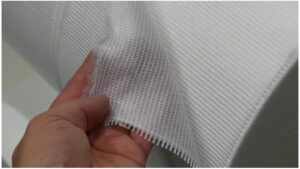
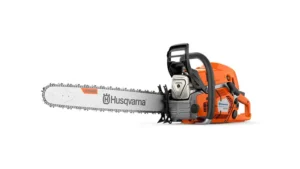
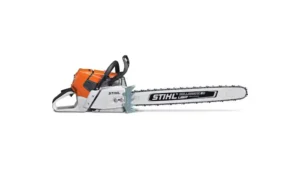

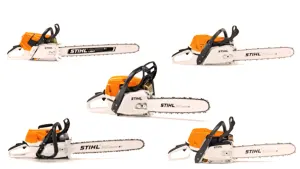
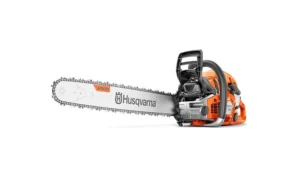

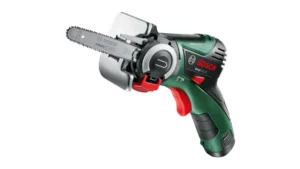
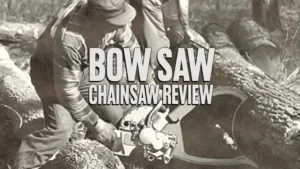
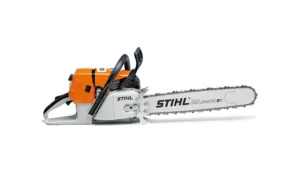
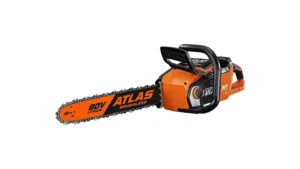

Leave your comment